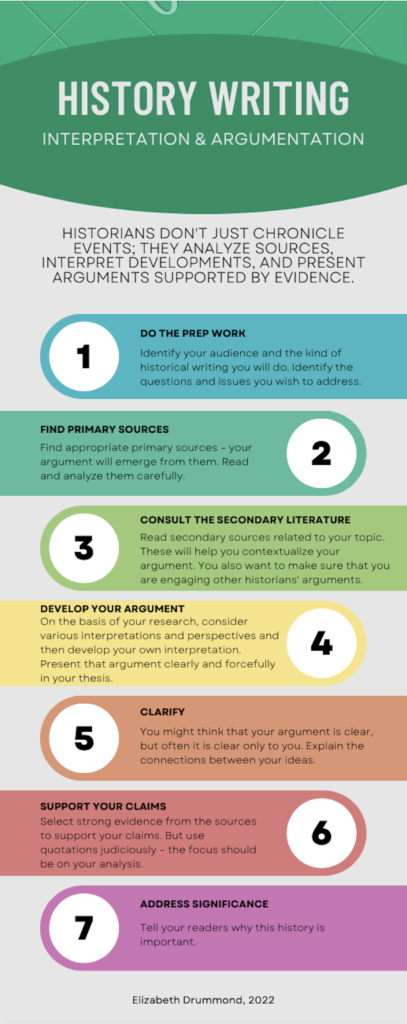Writing assignments in history courses require you to practice the craft of history – to read, think, and write historically. They are not tests of memorization, summaries of the readings and/or class notes, or chronicles of historical events. Rather, you will present and defend an argument, as historians do. “To give an argument” means “to offer a set of reasons or evidence in support of a conclusion.” An argument is not simply a statement of certain views (your opinion on an issue, whether you agree or disagree with a certain author, etc.). Rather, an argument is an attempt to support a certain view with reasons, examples, and evidence. You must incorporate evidence from the sources – as identified in the assignment or through your own research – to support your position. Don’t try to guess what I think; figure out your own argument and defend it. Remember that not all positions are defensible and not all arguments are good. But on some issues, there is more than one defensible position; state one and defend it!
Some tips as you sit down to tack writing history:
- Carefully read the assignment. Identify the questions and issues that you will need to address in your paper.
- Do your research:
- If you are required to do independent research, find and read primary and secondary source relevant to your research. The research stage of any writing assignment
- Take good notes on the sources (re-read them if necessary). Find an organizational approach that works best for you.
- Preparing to write:
- Before you even sit down to write, explore the arguments on all sides of an issue or question. Write a thesis statement. In doing this, consider the objections to that argument as well as alternate arguments. Be sure that your thesis presents an argument, not merely a road-map (a description of what you will discuss).
- Do an outline before you begin to write your paper. Planning is important! List the reasons (the individual points) for your argument, and then list the evidence that supports those points. Once you have developed a thesis and outlined your evidence, you can begin to write.
- Write!
- State your thesis clearly, concisely, and forcefully in your introduction. Without a strong thesis, you will not be able to develop a good argument. Keep your introduction brief, of a length appropriate to the length of the paper.
- Use topic sentences. The first sentence in each paragraph should announce not only the subject of the paragraph but the significance of the information that follows from it. The topic sentence is essentially the thesis of an individual paragraph, in which you present the main reasons in support of your overall argument.
- Foreground your own analysis. Present your ideas first and then use evidence from the sources to support it.
- Present your ideas in a logical order. Make sure that each paragraph (and idea) flows well from both its predecessor and to its successor. Make sure that all your ideas, moreover, refer back to and support your overall argument.
- Clarify. You may think that your argument is clear, but often it is clear only to you. Explain the connections between your ideas, even if they seem perfectly clear to you. Use lectures, class discussions, and secondary sources to help you make these connections.
- Some cautionary notes:
- Use quotations judiciously. The paper should present your analysis of the sources, and you should not use quotations as a substitute for that analysis. Overuse of quotations reduces the amount of space you have to develop your arguments and shows that you don’t have much more to say than the original document. Refrain from using block quotations in shorter papers unless the complete quotation is indispensable to your analysis.
- Post hoc, ergo propter hoc – “after this, therefore because of this.” Don’t assume that A caused B simply because B followed A. If you think that there is a cause and effect relationship between A and B, think it through thoroughly, consider alternate causes, and then explain adequately – that is, prove – how A caused B. Remember that causes may be complex; there is rarely only one.
- Do not claim more than you have shown. Avoid making grand, sweeping conclusions…unless you can prove your claims with reasons and evidence.
- Revise: Read feedback from me carefully and focus on addressing the most substantive points (in other words, don’t just correct the typos noted 😀). If you aren’t submitting a draft, then visit the Writing Center or have a friend read your paper and offer feedback.
- Proofread your paper carefully for proper spelling, grammar, punctuation, capitalization, verb tense, and sentence structure (see the writing resources on this website). Read your paper aloud or use the Read Aloud tool in Word (Review tab > Read Aloud) or a text-to-speech app. Hearing your own words can help you identify run-on sentences, awkward phrasing, and other problems that might otherwise escape your attention.

